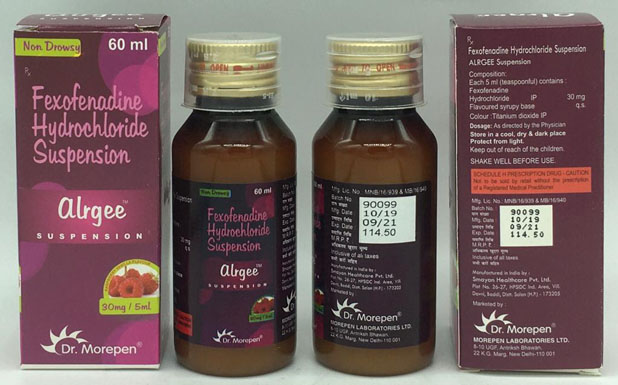Fexofenadine Suspension
Fexofenadine IP 30 mg
ALLEGRA is indicated for the relief of symptoms associated with seasonal allergic rhinitis in adults and children 6 years of age and older. Symptoms treated effectively were sneezing, rhinorrhea, itchy nose, itchy throat and red eyes.
Chronic Idiopathic Urticaria
ALLEGRA is indicated for treatment of uncomplicated skin manifestations of chronic idiopathic urticaria in adults and children 6 years of age and older. It significantly reduces pruritus and the number of wheals.
Mechansium Of Action:
Fexofenadine hydrochloride, the major active metabolite of terfenadine, is an antihistamine with selective peripheral H1-receptor antagonist activity. Both enantiomers of fexofenadine hydrochloride displayed approximately equipotent antihistaminic effects. Fexofenadine hydrochloride inhibited antigen-induced bronchospasm in sensitized guinea pigs and histamine release from peritoneal mast cells in rats. The clinical significance of these findings is unknown. In laboratory animals, no anticholinergic or alpha1-adrenergic blocking effects were observed. Moreover, no sedative or other central nervous system effects were observed. Radiolabeled tissue distribution studies in rats indicated that fexofenadine does not cross the blood-brain barrier.
Pharmacokinetics:
Absorption: Fexofenadine hydrochloride was rapidly absorbed following oral administration of a single dose of two 60 mg capsules to healthy male volunteers with a mean time to maximum plasma concentration occurring at 2.6 hours post-dose. After administration of a single 60 mg capsule to healthy volunteers, the mean maximum plasma concentration was 131 ng/mL. Following single dose oral administrations of either the 60 and 180 mg tablet to healthy adult male volunteers, mean maximum plasma concentrations were 142 and 494 ng/mL, respectively. The tablet formulations are bioequivalent to the capsule when administered at equal doses. Fexofenadine hydrochloride pharmacokinetics are linear for oral doses up to a total daily dose of 240 mg (120 mg twice daily). The administration of the 60 mg capsule contents mixed with applesauce did not have a significant effect on the pharmacokinetics of fexofenadine in adults. Co-administration of 180 mg fexofenadine hydrochloride tablet with a high fat meal decreased the AUC and Cmax of fexofenadine by 21 and 20% respectively.
Distribution: Fexofenadine hydrochloride is 60% to 70% bound to plasma proteins, primarily albumin and α1-acid glycoprotein.
Metabolism: Approximately 5% of the total dose of fexofenadine hydrochloride was eliminated by hepatic metabolism.
Elimination: The mean elimination half-life of fexofenadine was 14.4 hours following administration of 60 mg twice daily in healthy volunteers.
Human mass balance studies documented a recovery of approximately 80% and 11% of the [14C] fexofenadine hydrochloride dose in the feces and urine, respectively. Because the absolute bioavailability of fexofenadine hydrochloride has not been established, it is unknown if the fecal component represents primarily unabsorbed drug or the result of biliary excretion.
The most commonly reported adverse effects are:
- Nausea
- Diarrhea
- Drowsiness
- Headache
Store in a well closed container in cool, dry place, away from direct heat and light.
